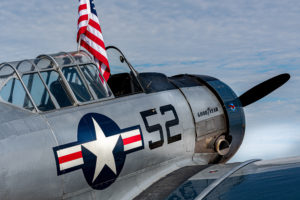
DENVER, COLORADO / USA – July 27, 2019: World War II era military airplanes on display and flying at the 2019 WarBird Auto Classic, a showcase event at the Colorado Air and Space Port.
The opportunity to purchase a military aircraft or warbird is an exciting one. It is a chance to own a piece of history! However, any potential buyer or seller of a warbird needs to be aware of not only citizenship issues with the FAA, but also with the International Traffic in Arms Regulations issued by the United States Department of State as well as the similar Export Administration Regulations issued by the United States Department of Commerce. These regulations come into consideration with any transaction that involves a non-US person. This article provides a brief highlight of the issues related to the International Traffic in Arms Regulations.
The purpose of the International Traffic in Arms Regulations (“ITAR”) is to “control the sale of defense items and defensive services.”[1] Military aircraft are considered to be defense items and are subject to ITAR. Aircraft are specifically referenced in 22 CFR 121.1 – The United States Munitions List. This list includes bombers, fighters, fighter bombers, fixed wing attack aircraft and turbofan- or turbojet-powered trainers used to train pilots for fighter, attack, or bomber aircraft.[2] It is important to note that training aircraft are included in the definition of a “defense item” and are subject to ITAR. Additionally, the definition of a “defense item” does not distinguish between a United States object or foreign object. As such, both American military aircraft as well as foreign manufactured aircraft (such as the Aero Vodochody L-39) are subject to ITAR.
The ITAR specifically applies to the export of defense items and defensive services. However, the term “export” in the ITAR is not similar to an export for customs purposes where the item physically leaves the United States. The definition of an export in the ITAR includes “transferring registration, control, or ownership of any aircraft…subject to the ITAR by a U.S. person to a foreign person.”[3] Therefore, any transaction that involves the transfer of the registration of an aircraft from a U.S. person to a foreign person, even if the aircraft stays on the FAA registry and remains in the United States, is subject to ITAR. In addition, the definition of export provides for a “deemed export” which is defined as the “releasing or otherwise transferring technical data to a foreign person in the United States.”[4] This means that sharing technical information about a warbird with a non-US person or allowing a non-US person to use your warbird in the United States are deemed exports that trigger the ITAR.
This article is intended to highlight the potential ITAR issues involved in transactions with military aircraft. For additional information, please contact the attorneys at Aero Law Group PC and they will be happy to assist you.
[1] https://www.export.gov/article2?id=International-Traffic-in-Arms-RegulationsInternational-Traffic-in-Arms-Regulations
[2] 22 CFR 121.1(a)(1)-(3)
[3] 22 CFR 120.17(a)(3)
[4] 22 CFR 120.17(a)(2)

